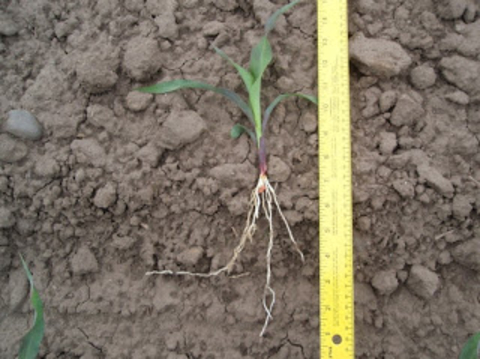What you need to know
-
The most favorable planting depth, planting dates, planting rates and soil temperature for Minnesota.
-
How to ensure good seed-to-soil contact.
-
Key factors for avoiding risk and maximizing economic return.
When corn growers follow planting best practices, they position themselves to optimize grain yield and economic return. Here, we outline several key factors for corn planting success in Minnesota, based on extensive research by the University of Minnesota.
Avoid tillage and planting on wet soils
Generally, a field is ready for seedbed preparation when soil in the tillage zone crumbles when squeezed.
Preplant tillage and planting on wet soils can cause a number of problems. When planter disc openers cut through wet, fine-textured soil, the soil around the seed becomes too compacted, making it difficult for nodal roots to penetrate. Pre-plant tillage also creates a compacted layer below the tillage zone, further restricting root development.
In addition, planting on wet soils can create a cloddy seedbed and cause seed furrows to open after planting, diminishing seed-to-soil contact. Good seed-to-soil contact is important, so seeds can quickly and evenly absorb moisture and emerge uniformly.
Avoid excessive preplant tillage
Prior to planting, avoid tilling more than necessary. Excessive preplant tillage causes surface crusting and emergence problems if it rains heavily prior to emergence, and increases the risk of wind erosion and sandblasting to corn seedlings.
Optimal planting depth
For most situations in Minnesota, planting corn 2 inches deep is optimal. Placing seeds at a shallower depth increases the risk of poor nodal root establishment. If soils are very dry, planting as deep as 2.5 inches to reach soil moisture can improve the uniformity of emergence.
Avoid high planting speeds that make planter units bounce, as this can cause variable depth of seed placement and uneven emergence.
Plant at the most opportune time
Germination of corn requires that seeds take up 30% of their weight in water and that soil temperature be at least 50 degrees F. There is less chance of stand establishment problems if corn in planted when soil in the seed zone has reached or is near 50 degrees F and is expected to warm, since water uptake by seeds can occur when soils temperature is below 50 degrees F.
It's important to consider the forecasts for weather and soil temperature after corn planting. Imbibitional chilling injury to corn can occur when soil temperature is near 40 degrees F or lower within 1 to 2 days after planting. Imbibitional chilling injury occurs because cellular tissues are less flexible under cold temperatures and can break when seeds imbibe water. If soil temperature drops to 40 degrees F or lower beyond 2 days after corn planting, the risk of imbibitional chilling injury is greatly reduced compared to a similar decline in soil temperature during the first 1 to 2 days after planting.
Generally, Minnesota corn growers maximize yield when planting in late April or early May.
When spring arrives early, a mid-April planting date can produce similar yield as planting in late April or early May. When few growing degree days accumulate in late April and the first half of May, growers can also reach maximum corn yields by planting in mid-May.
In most cases, corn yield in Minnesota decreases when planting is delayed beyond mid-May. If planting is delayed until May 22 or later, switching from late-maturity hybrids to earlier-maturity hybrids reduces the risk of corn freezing in the fall before reaching maturity.
Guide: Considerations for late-planted corn in Minnesota
Plant seeds at a rate that maximizes economic return
Optimal planting rates for corn in Minnesota are generally 34,000 to 36,000 seeds per acre. This rate maximizes economic return in most Minnesota fields, but can vary depending on the hybrid, soil productivity and expected yield.
A final stand that’s 5 percent less than the planting rate is common. Planting too many seeds generally does not reduce corn yield, but it can reduce economic return.
How seeding rate and other factors impact plant population
Reviewed in 2021


